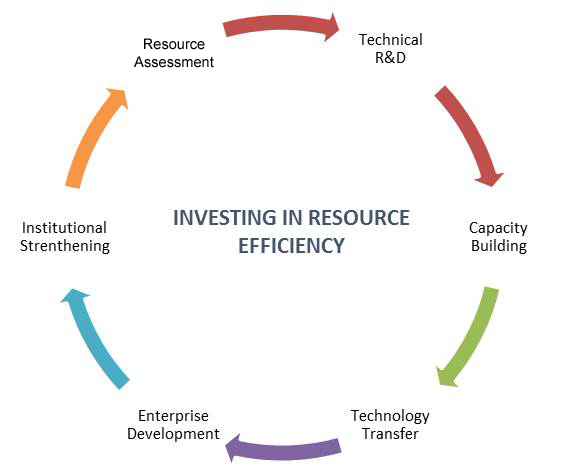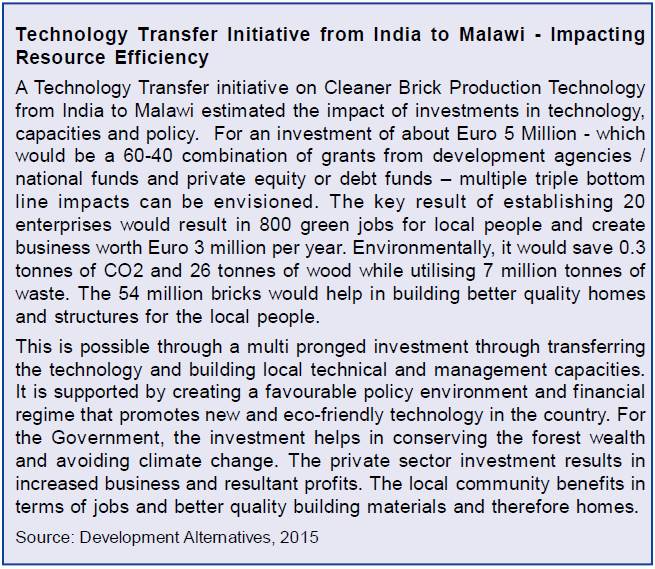|
Investing in Resource Efficiency
Addressing Resource Efficiency T he Indian construction sector is booming with increasing public and private investment. This boom translates directly into an increased consumption of natural resources like land, water and materials. An extremely resource and energy intensive sector, construction in India is already the second largest sector with regard to material consumption as of 2007, accounting for around 20% of all material demand, growing by over one billion tonnes from 1997 (SERI, 2012).These resource, especially material resources like soil, sand etc. are the limiting factors impacting growth in the sector. Sand scarcities have already made headlines, resulting in both an increased cost of construction as well as the pursuit of alternatives.The anticipated escalated growth in the sector,
necessitates looking at resource efficiency not just from an
environmental stand point but also for more basal economic reasons.
Regulatory measures like bans on soil and sand mining make it harder for
entrepreneurs to obtain raw materials. Delays in material supply have a
direct consequence on the cost of construction - increasing project
costs and pushing affordability out of the window. Alternatives like
m-sand (manufactured sand) made from stone, a far more abundant resource
or recycled aggregates from construction and demolition waste are
beginning to be available in the market. This reduces pressure on
primary resources while providing a quality economical option to a
scarce product. Thus transitioning towards resource efficiency is seen
to offer multiple benefits across the triple bottom line.
Additionally, in the wake of signing the Sustainable Development Goals (SDGs), resource efficiency as an approach assumes an important position. It directly is reflected in Goal 12 on ensuring sustainable consumption and production patterns specifically in terms of substantially reducing waste generation through prevention, reduction, recycling and reuse. Also relevant to the construction sector is Goal 9 and 11 which looks at sustainable industrialisation and sustainable urbanisation respectively. This fits in very well with the national priority the Government has set itself through the Missions on Urban Transformation (SMART Cities and AMRUT) encouraging sustainable development in urban India. However it is not just the Urban Missions that are needed to address concerns of resource efficiency. Make in India and Skill India become interesting venues to define resource efficiency tactics while pursuing the path to growth and development. Promoting Resource Efficiency In order to promote resource efficiency, investing in technologies and practices that adopt these principles is paramount. These investments need to come in at various points in the life cycle of the technology. While there are some construction technologies that subscribe to these principles, they are yet to be mainstreamed. Also conventional technologies do not acknowledge the criticality of resource availability. Thus technical research and development and then the subsequent transfer of this knowledge are essential to come up with alternative resource efficient pathways for development. The investment in research includes both, costs related to technologies being developed as well as the infrastructure that needs to be set up for the research. Research on elements of frameworks and assessments often neglected are important to establish the need for resource efficiency as well as monitor and track progress at a later stage. Overall resource efficiency needs to become a pre-requisite for the research and development undertaken in order to continue on the path of sustainable development. Besides hard costs related to technology and infrastructure to support technology development, capacities are a very crucial point of investment. A trained cadre of technicians and operators to manage day to day functioning, trouble shooting and servicing of the technology form a key component of the value chain of resource efficient technologies. Thus capacity building and training are essential to successful adoption of resource efficiency. Once technologies and technology packages have been developed, the private sector plays a significant role in adopting and utilising them to create impact. The lab to land connect needs to be strengthened for research to bear fruit. When research is funded by the private sector, this transition is often seamless. When there are multiple stakeholders involved, this becomes tricky. Support to the private sector is needed both in terms of technical and financial assistance. This requires a favourable policy environment and systemic mechanisms to function impeccably to allow for transitioning from one part of the lifecycle of the technology to another without encountering major hiccups. Thus institutions that support these investments like research, capacities, regulation, finance, etc. need to be strengthened so resource efficiency is mainstreamed in their approach and operation. Financing Resource Efficiency India currently spends about 0.84% of its GDP on
research and development. This is a pitiable amount compared to other
developed nations – Germany, USA, China and France that spend 2.9, 2.7,
2.08 and 1.9 % of their GDP respectively on research and development.
Capacity building and institutional strengthening are soft areas often
listed as fundamental but do not find an earmarked financial allocation.
If India spent a modest 2 % of its GDP on research and development, the
finance required from 2015 to 2030 in 2014-15 prices is INR 60 lakh
crores (USD 950 billion), with an expected shortfall of INR 35 lakh
crores (USD 555 billion) (Development Alternatives, 2015).
Traditionally the state has been viewed as the key investor in India, supported by development funds from other countries, multi and bi-lateral agencies etc. However, it is expected that this shortfall will now be met by a combination of sources, with the private sector also pitching in substantially. A part of these finances would have to be directed towards research and development in the building materials and construction sector. Models like ‘Public Private Partnership’ help mitigate some risk to the private sector and encourage the uptake of such technologies. The Construction and Demolition waste processing facilities set up in Delhi and Ahmedabad offer evidence to this point. Once techno-commercial feasibility has been proved, it has been seen that the private sector including the Micro, Small and Medium Enterprise (MSME) sector, willingly invests in resource efficient technologies as seen in the case of fly ash. Fly ash bricks produced by the MSME sector account for 10-12 % of the entire brick market in the country today. Since both debt and equity form a component of this investment, getting financial agencies on board is key to enterprise development. Innovative financial products like performance linked subsidies and incentives help promote the uptake. Conclusion The investment towards resource efficiency cannot and must not remain a public sector prerogative. The need of the hour is for the public and private sector to work together at the local, national and global level to effect the transition towards resource efficiency. What is also important is building a common understanding on the need for resource efficient interventions and their impacts on the triple bottom line. The essential investments in taking up resource efficiency lie in the strengthening of systems and structures that cater to development and dissemination of materials, technologies and practices that promote optimal utilisation of limited resources. Thus investments need to be plugged in for: • Metrics and assessment of critical resources across sectors to develop synergies and measure impact• Research and development of technologies for mitigating trade-offs between competing uses of critical resources• Technology and knowledge transfer of techniques and technologies adopting resource efficiency• Capacity building and training to create a skilled work force equipped to deal with new technologies and practices• Supporting the private sector to adopt these technologies to directly address resource concerns at the plant / unit level• Strengthening institutions for mainstreaming resource efficiency at the national and local level qKriti Nagrath References • Development Alternatives. (2015). Achieving the Sustainable Development Goals in India: A Study of Financial Requirements and Gaps. United Nations Development Programme.• SERI. (2012). Material Flows database. www.materialflows.net.• Open Working Group proposal for Sustainable Development Goals |

